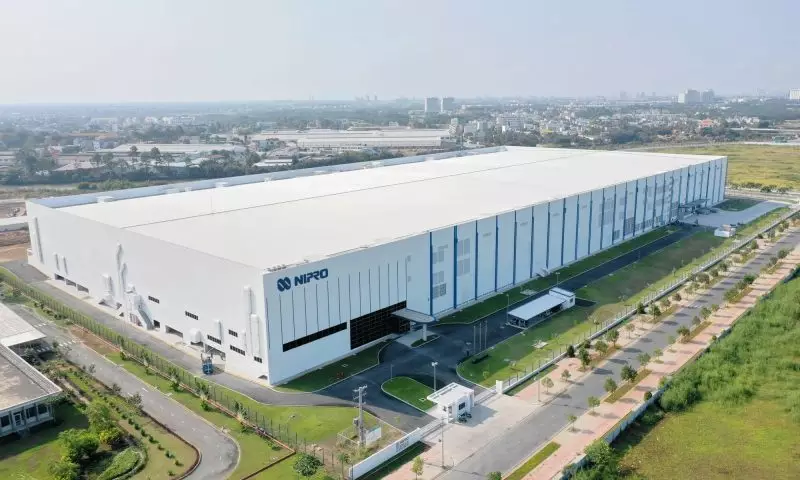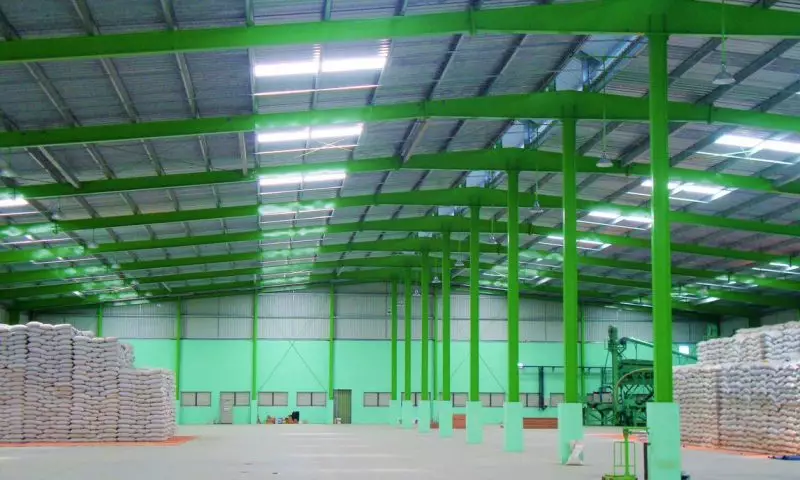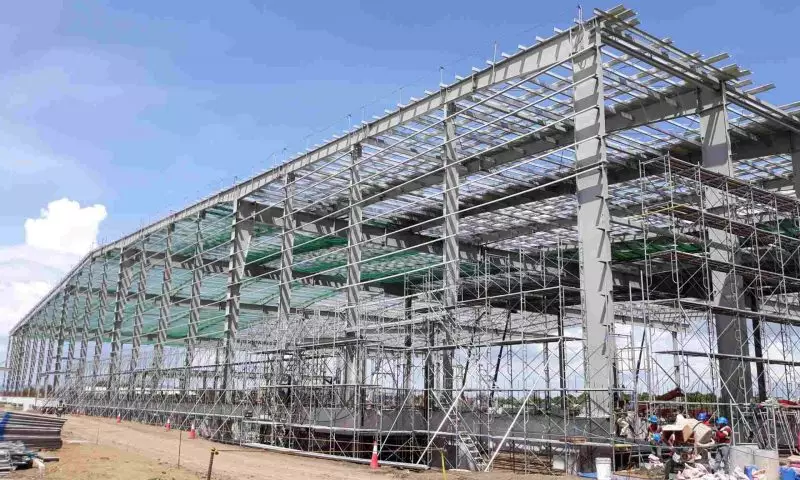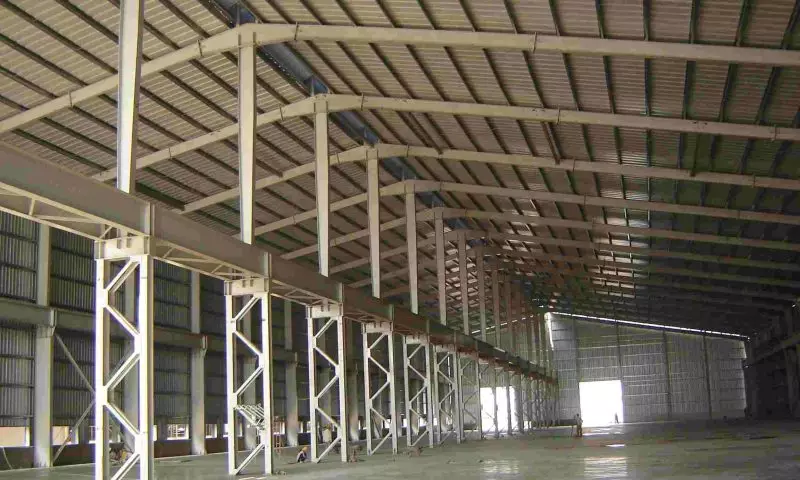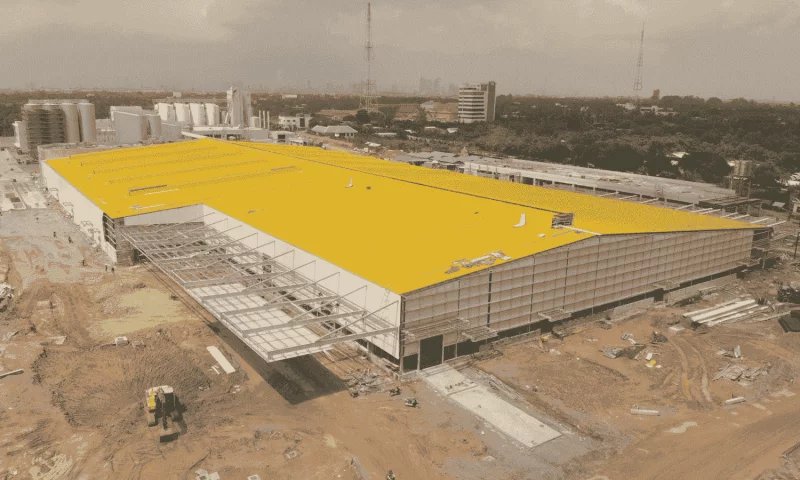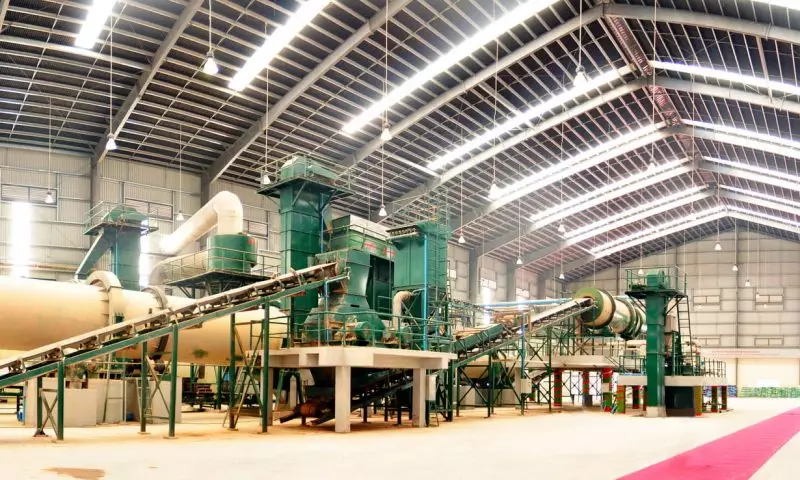Factory and warehouse construction entails inherent risks of fire and explosion due to the concentration of flammable materials and hazardous chemicals. This article will provide you with detailed information on mandatory fire prevention regulations in construction:
1. Definition of Fire Resistance in Factory and Warehouse Construction
Fire resistance in the steel factory and warehouse construction refers to the ability of the structure to resist the development and spread of fire in the event of a fire or explosion incident. This ability is assessed based on the following factors:
- Fire resistance rating of the building structure: The time duration during which the structure can withstand the impact of fire before collapsing or losing load-bearing capacity. Fire resistance ratings are classified into grades: Grade I (highest), Grade II, Grade III, and Grade IV (lowest).
- Fire spread prevention capability: The ability to prevent the spread of fire from one area to another within the structure. Fire spread prevention capability is evaluated based on factors such as building materials, structural design, and fire prevention measures (firewalls, fire doors, etc.).
- Escape capability: The ability to ensure the safety of personnel and property within the structure in the event of a fire or explosion incident. Escape capability is assessed based on factors such as the number and location of emergency exits, the size and slope of emergency exits, fire alarm systems, and evacuation instructions.
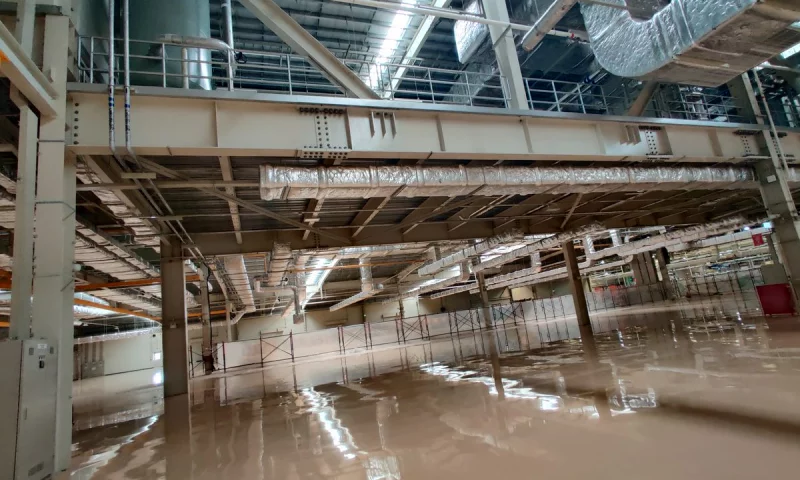
Definition of fire resistance in steel factory and warehouse construction
See more: Warehouse Construction Process and Keys Factors to Note
2. Importance of Fire Prevention Regulations in Factory and Warehouse Construction
2.1 Protection of Life and Health
Fires in factory and warehouse buildings can cause extensive damage to human life, including casualties and long-term health effects. Fire prevention regulations help minimise the risk of fire incidents, thereby protecting the lives and health of workers and stakeholders.
2.2 Minimise Property Damage
Factory and metal storage buildings often contain valuable materials and expensive machinery and equipment. Fires can destroy entire properties, resulting in significant economic losses for businesses. Fire prevention regulations help minimise the risk of fire incidents, thereby protecting business assets.
2.3 Ensuring Business Operations
Fires can cause severe damage to factory and warehouse buildings, forcing prolonged cessation of business operations. This affects production schedules, leading to revenue losses and damage to the reputation of the business. Fire prevention regulations help minimise the risk of fire incidents, ensuring smooth business operations.
2.4 Compliance with Legal Regulations
The construction of factory and steel storage buildings must comply with legal regulations regarding fire prevention and firefighting. Fire prevention regulations are an essential part of ensuring that the structure meets legal requirements.
2.5 Raising Awareness of Fire Fighting and Prevention
Implementing fire prevention regulations contributes to raising awareness of fire fighting and prevention among employees, reducing safety violations that may lead to fires.
2.6 Creating a Safe Working Environment
A safe working environment enhances labour productivity and morale. Fire prevention regulations contribute to creating a safe working environment, ensuring the health and wellbeing of workers.
In addition to the above reasons, implementing fire prevention regulations also contributes to environmental protection and urban landscape preservation, demonstrating the business’s responsibility to the community.
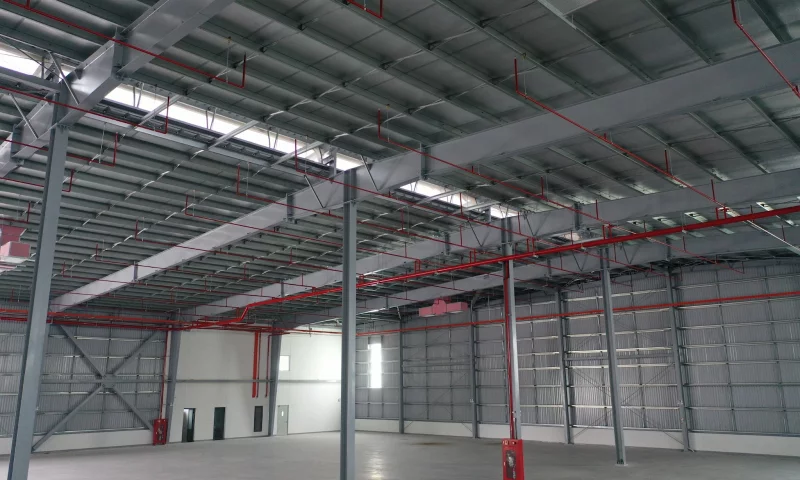
The importance of fire protection regulations in the construction of factories and steel warehouses
3. Fire Resistance Levels in Factory and Warehouse Construction
Fire resistance levels are divided into 5 grades, from I to V, corresponding to decreasing fire resistance capabilities:
3.1 Grade I:
- Has the highest fire resistance limit, with a minimum of 240 minutes for walls, columns, and floors.
- Applied to structures with high fire safety requirements, such as warehouses storing flammable materials, gas storage warehouses, chemical plants, etc.
3.2 Grade II:
- Has fire resistance limits from 180 to 239 minutes for walls, columns, and floors.
- Applied to structures that have significant economic, cultural, and social importance, such as shopping centres, cinemas, hospitals, schools, etc.
3.3 Grade III:
- Has fire resistance limits from 120 to 179 minutes for walls, columns, and floors.
- Applied to common structures such as residential buildings, office buildings, production factories, steel storage buildings, etc.
3.4 Grade IV:
- Has fire resistance limits from 60 to 119 minutes for walls, columns, and floors.
- Applied to structures with low fire resistance requirements, such as simple factory buildings, temporary houses, simple factories, etc.
3.5 Grade V:
- Has fire resistance limits below 60 minutes for walls, columns, and floors.
- Applied to structures with low requirements for fire resistance, such as sheds, temporary metal storage buildings, etc.
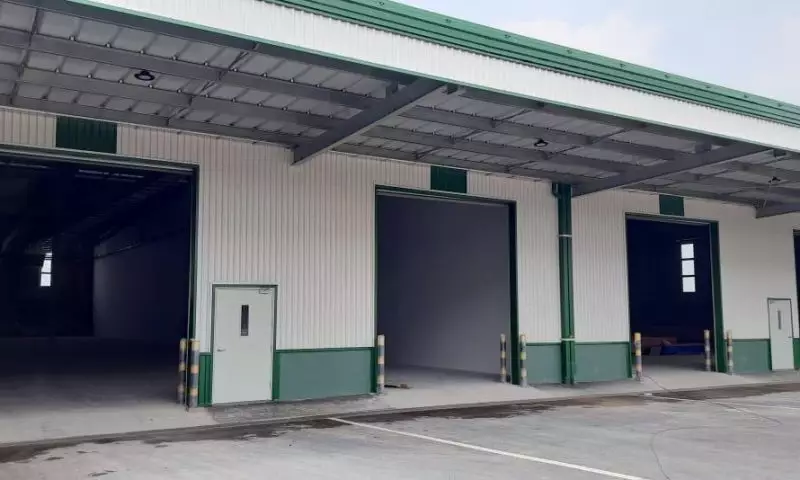
Fire resistance levels in warehouse construction
4. Fire Prevention Regulations in the Construction of Steel Factories and Warehouses
4.1 According to Building Types
- For factory producing flammable materials:
- Require automatic fire detection and suppression systems capable of quickly detecting and extinguishing fires.
- Require an effective ventilation system to remove toxic gases and smoke from the factory.
- Require a dedicated storage area for flammable materials with strict safety measures.
- For factory producing chemicals:
- Require fire detection and suppression systems suitable for the types of chemicals used.
- Require an acid/base neutralisation system to handle chemical spills.
- Require a separate area for chemical storage, with strict safety measures.
- For warehouses storing goods:
- Require fire detection and suppression systems suitable for the types of goods stored.
- Require a ventilation system to ensure air circulation and prevent the accumulation of toxic gases.
- Require spacious emergency exits to ensure quick evacuation in case of fire.
4.2 Steel Structures:
- Fire protection for steel structures: Use fire-resistant paint, fire-resistant coatings, or lightweight concrete to protect steel structures from high temperatures and prevent collapse in case of fire.
- Zone division: Divide the factory into separate zones with fire-resistant partitions, fire doors to limit the spread of fire.
- Structural design: Ensure steel structures can withstand high loads in case of fire, avoiding collapse due to overload.
4.3 Roofing:
- Roof covering: Use fire-resistant roofing materials such as galvanised steel sheets, fiber cement sheets, polycarbonate sheets, etc.
- Ventilation system: Install a roof ventilation system to remove hot smoke and toxic gases from the factory, reducing the temperature during a fire.
- Skylights: Design skylights to create natural ventilation, support smoke evacuation, and reduce temperature.
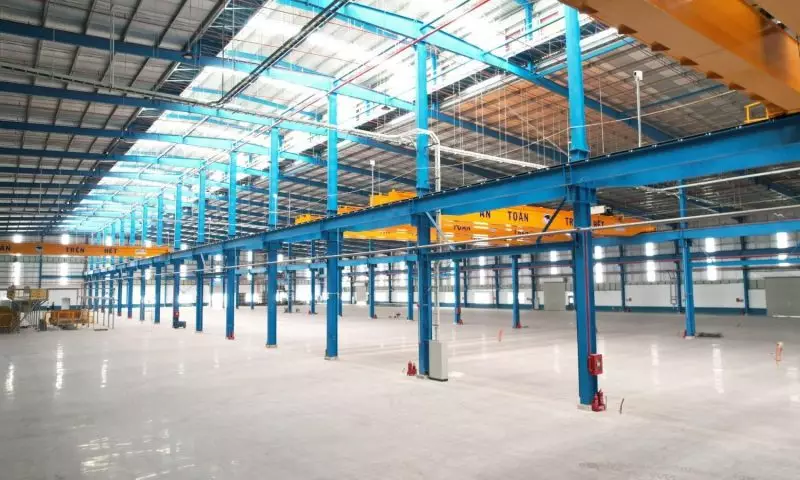
Ventilation system & skylights in roof construction
4.4 Door Systems:
- Fire doors: Install fire doors at emergency exits, entrances to high-risk areas, and partition doors to prevent the spread of fire.
- Emergency exits: Ensure an adequate number, size, and location of emergency exits according to regulations, convenient for movement in case of fire.
- Signage: Install clear and visible emergency exit signs at emergency exits.
4.5 Fire Fighting and Prevention Systems:
- Fire alarm system: Install automatic or semi-automatic fire alarm systems to detect fires early.
- Fire suppression system: Install a fire suppression system suitable for the type of factory, fire risk, and materials used. Firefighting systems can include water spray systems, foam fire fighting systems, gas fire fighting systems, etc.
- Fire extinguishers: Equip with sufficient portable fire extinguishers suitable for the types of flammable materials present in the factory.
4.6 Fire Fighting and Prevention Management
- Fire Fighting and Prevention Planning: Develop detailed fire fighting and prevention plans, including fire prevention measures, firefighting strategies, and evacuation plans in case of a fire incident.
- Fire Fighting and Prevention Training: Organise regular fire fighting and prevention training sessions for staff to enhance awareness and firefighting skills.
- Periodic Inspection: Regularly inspect the fire fighting and prevention system, emergency exits, and firefighting equipment to ensure safety.
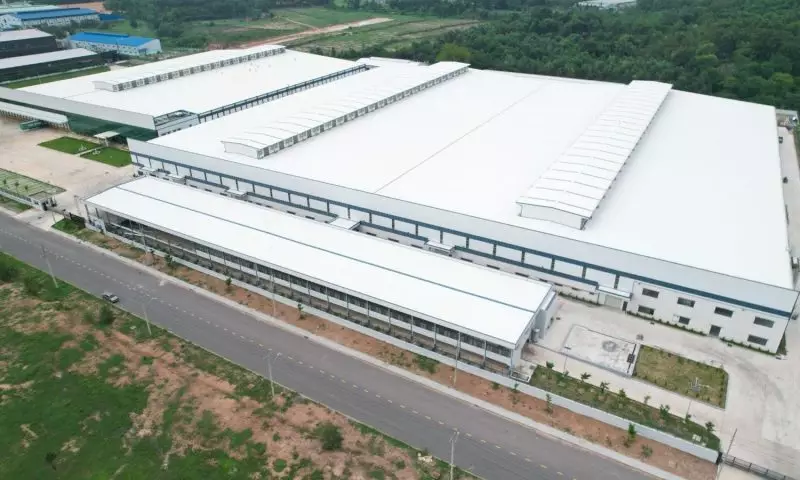
Fire protection regulations in the construction of factories and steel warehouses
5. Fire Resistance Materials for Steel Factories and Warehouses
5.1 Fire-Resistant Steel
- Fire-resistant steel is a type of steel coated with a layer of paint or a special coating that can withstand high temperatures, helping to protect the steel structure from deformation or collapse due to the impact of high temperatures in the event of a fire.
- Fire-resistant steel is used for main structures such as columns, beams, and rafters when constructing steel warehouses and factories.
5.2 Lightweight Concrete
- Lightweight concrete is a type of concrete produced from materials with low specific volume such as cement, lightweight aggregates (perlite, fly ash, slag), and additives.
- Lightweight concrete has high fire resistance, good insulation properties, and is lighter than regular concrete, helping to reduce the load on the structure of steel factories and warehouses.
- Lightweight concrete is used for partitions, floors, and roofs in steel factories and warehouses.
5.3 Fireproof Gypsum Board
- Fireproof gypsum board is a type of gypsum board manufactured from gypsum core and fiberglass reinforcement, with high fire resistance, good sound insulation, and easy installation.
- Fireproof gypsum board is used for partitions, ceilings, etc., in steel factories and warehouses.
5.4 Zinc-Coated Fire-Resistant Sheet
- Zinc-coated fire-resistant sheet is a type of zinc-coated sheet metal coated with a layer of paint or a special coating with high fire resistance, helping to protect the roof from spreading fire.
- Zinc-coated fire-resistant sheet is used for roofs, partitions, etc., in the construction of steel warehouses and factories.
5.5 Fire-Resistant Glass
- Fire-resistant glass is produced from multiple layers of thin glass laminated together with a special adhesive layer, with high heat resistance and the ability to prevent fire spread.
- Fire-resistant glass is used for windows, partitions, etc. when constructing steel warehouses and factories.
5.6 Fire-Resistant Coating
- Fire-resistant coating is a layer of material applied to the surface of structures, building materials to protect them from the impact of high temperatures in the event of a fire.
- Fire-resistant coating can be made from various materials, such as fire-resistant paint, fire-resistant mortar, fire-resistant adhesive, etc.
- Fire-resistant coating enhances the fire resistance of structures, building materials, limits fire spread, and protects people and property.
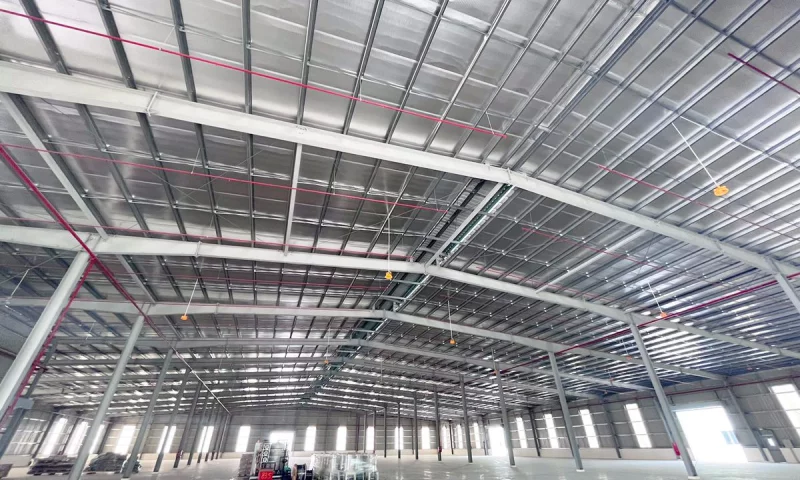
Fireproof materials in the construction of factories and steel warehouses
6. Fire Prevention Construction Techniques in the Construction of Steel Factories and Warehouses
6.1 Fire-Resistant Steel Structure Construction
- Use fire-resistant steel or fire-resistant paint for steel structures.
- Treat fire resistance for joints, gaps between steel structures using methods such as welding, applying fire-resistant mortar, using fire-resistant tape, etc.
- Encase steel structures with lightweight concrete or fire-resistant mortar to enhance fire resistance.
6.2 Fire-Resistant Partition Construction
- Use fireproof bricks or fireproof gypsum boards to construct partitions.
- Treat fire resistance for gaps, joints between partitions using methods such as applying fire-resistant mortar, using fire-resistant adhesive, etc.
- Install fire-resistant doors at entry and exit points of partitions.
- Fire-resistant doors must meet fire resistance standards as required by regulatory authorities.
6.3 Fire-Resistant Roof Construction
- Use zinc-coated fire-resistant sheets or fireproof roofing sheets for the roof.
- Treat fire resistance for gaps, joints between roofing sheets using methods such as applying fire-resistant mortar, using fire-resistant adhesive, etc.
- Install roof ventilation systems to vent hot smoke and toxic gases in the event of a fire.
6.4 Fire Alarm System Construction
- Install fire alarm devices such as smoke detectors, heat detectors, fire alarm bells, etc., at high-risk locations in factories and warehouses.
- Connect the fire alarm system to fire suppression and ventilation systems to activate automatically in case of emergencies.
- The fire alarm system must be installed and maintained according to regulations.
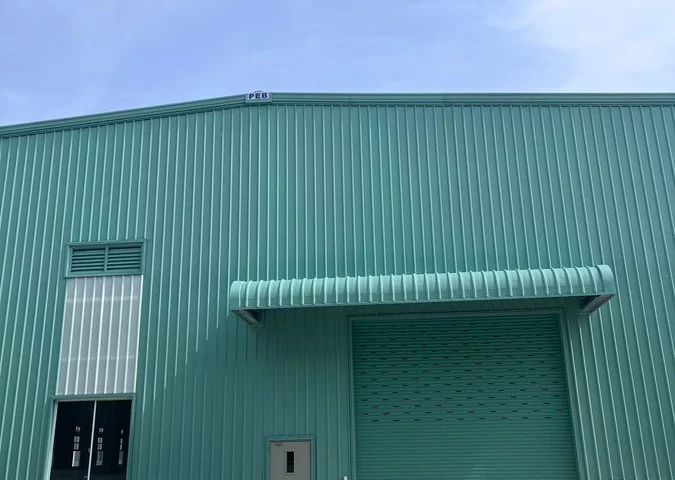
Fire prevention construction techniques in steel factory and warehouse construction
The construction of safe steel factories and warehouses requires strict compliance with fire prevention regulations. This article has provided detailed information on mandatory fire fighting and prevention regulations, contributing to the construction of safe, efficient projects, and protecting people and property.
If customers are looking for comprehensive solutions for building steel warehouses and factories, please contact Pebsteel via email at [email protected] or phone: (+84) 908 883 531 for an immediate consultation today.





